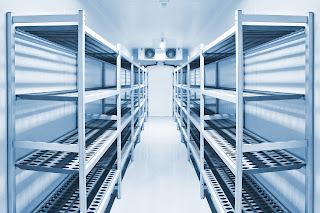 |
| Creative cooling system designs, coupled with smart controls, can improve cold room performance and reduce risk. |
Effectively implementing a plan that reduces risk in cold storage facilities will require participants with more than just a familiarity with refrigeration system operation. Here is a list of some subjects of technical expertise that should be part of the solution.
- Refrigeration system operation - This seems obvious, but what is needed is a somewhat more detailed knowledge of how refrigeration systems work. The expertise is useful for developing a hierarchy of all the potential failure scenarios, how to detect them and respond.
- Refrigeration compressor failure - Risk reduction involves focusing on all the things that can go wrong. Not everyone is adept at doing this, but for the purposes of this project it is a useful skill.
- Sensing and measurement technology - Cold space temperature failure only occurs after mechanical failure. Relying on temperature as the only indication of failure overlooks the benefits derived from direct monitoring of equipment operation.
- Control system complexity - Regulating and coordinating all the various facets of system operation is challenging when multiple cooling systems are involved. The control system must be capable of delivering proper cold space performance under a number of operating equipment scenarios. Two cooling systems could be active, or either of the single units in coordination with one another or alone.
The control system is the key to gaining the most advantage of any additional expense for backup refrigeration equipment. Monitoring equipment operation will enable early detection and alert for a number of indicators of impending or immediate equipment malfunction. Here is a short list of the essential performance parameters to monitor.
- Room temperature - Obvious, with no explanation needed.
- Refrigeration compressor motor current - This is easily and economically accomplished. It provides an indication of whether the compressor is operating in response to controller command, as well as key information about compressor performance.
- Refrigerant discharge and suction pressure - This can be used to assess system performance in relation to an established baseline. Additionally, there are numerous opportunities to utilize discharge and suction pressure relationships as indicators of refrigeration system health.
- Evaporator fan motor current - The fans that move air through the cold space are driven by one or more motors which are part of the equipment needed for expected performance. Motor health and performance can be determined using fan motor current.
There is plenty involved in deriving the maximum benefit from the additional cost for backup equipment. System control is easily accomplished with a properly programmed PLC. Understanding the interrelation of multiple systems operating on a single cold space is key to implementing a successful solution.
Share your cold storage concerns and challenges of any scale with equipment planning experts. Leverage your own knowledge and experience with their application expertise to develop an effective solution.


